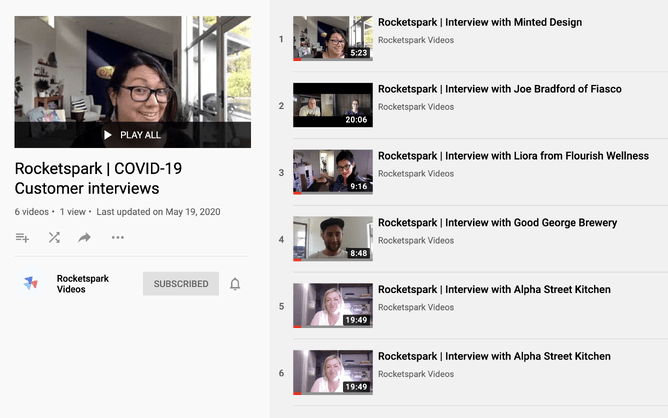Chances are, you’ve watched an online video today. According to Digital Sherpa, the average internet user watches 32.2 videos per month—more than one a day. In fact, one-third of all internet activity is video viewing. The internet is becoming—nay, has become—a videographic medium. Is your website keeping pace?
Creating videos for your business’s website might sound like a lot of work and, admittedly, video production takes more time/money than simply writing something. But, used well, video can be a powerful tool to generate more web traffic and, ultimately, more sales.
Why use video on your website?
Video improves engagement
Anecdotal evidence alone is probably enough to convince most of us that video is more engaging than plain text, but have you ever wondered why? Psychologist Susan Weinschenck identified four reasons we’re suckers for video:
- We’re hard-wired to pay attention to faces.
- Information is conveyed through tone of voice.
- We “catch” emotions off others.
- Movement grabs and holds our attention.
Video increases trust
Ecommerce relies on trust—what’s one way to boost trust? Video. There’s a serious amount of legitimacy implied by video even when the video isn’t even watched. ReelSEO conducted some research and discovered that merely offering video increased conversions, regardless of whether or not users actually watched the video. Seems odd, I know, but offering video shows that you believe in your products and that you’re willing to invest in your website experience. In other words, it shows that you’re trustworthy.
Video improves search rankings
If you’ve ever wondered how you might get your website to show up on page one of Google’s search results, video might be part of the answer: video is 50 times more likely to rank well than a plain-text site. How do you help your video rank well in Google? This is a question about search engine optimisation (SEO) and we’ve discussed SEO extensively before. Video SEO is similar to ordinary SEO—all the usual tips and tricks apply. You need to use keywords in the video’s titles, descriptions and tags. Creating a transcript of your video can give you an SEO boost too. Tune up on SEO here.
Video increases conversions
If you’re selling online, then this is the biggie. Marketing researchers Wyzowl found that in a review of marketing in 2019 80% of video marketers say video has directly helped increase sales, with 89% saying video, in general, gives them a good return on their investment.
When NOT to use video
There’s a pseudo-scientific figure that’s often trotted out in support of video content: one minute of video is worth 1.8 million words. Bullpucky—it’s not. The guy credited with this specious “fact” (he has a PhD so, hey, it’s gotta be true!) has apparently arrived at the figure by multiplying the number of frames in a minute’s worth of video (1,800 [30 frames x 60 seconds], as if you could absorb each frame individually!) by 1,000, based on the highly unscientific notion that a picture is worth a thousand words (scientifically, a picture is worth 1.5 words—at least, when it comes to memory). So don’t believe the hype about video. There are times that text is the way to go.
It’s all about knowing when to use what. As media theorists will tell you, the medium matters just as much, if not more, than the information it conveys (and, as web marketing expert Neil Patel discovered, getting it wrong can be costly). Different technologies affect us in different ways, to the point of even altering how our brains work (see, for example, Nicholas Carr’s piece in The Atlantic, “Is Google Making Us Stupid?” His answer: Yes). In other words, the text and video on your website aren’t just neutral, passive communication channels that convey identical information—they actually do different stuff with that information.
What do images and words do differently? Video makes you feel; text makes you think. Visual media tends to be more emotive, which is why video is ideal for sharing customer stories or highlighting the user experience—seeing and hearing makes your website visitor feel something, which in turn might just compel them to convert. Textual media tends to be more analytical, so it’s a great way to deal with facts and data where the point is to communicate the essential information rather than convey a whole experience, like product specs and prices. Of course, these aren’t hard-and-fast distinctions and many web videos combine both, like videos that present words and stats in a visually interesting way. But these are genuine tendencies, so whenever you’re deciding between text and video, ask yourself: what’s the goal of this information?
There is a more mundane consideration here too: time. Text can be scanned, skimmed and skipped—great when you’re in a hurry (which, let’s face it, is pretty much always). Video usually requires a time commitment that we’re often not willing to invest. Most adults read between 250 and 300 words per minute but speak just 150 words per minute. If you’re trying to get a lot of information across, text is often more efficient. And, of course, sometimes the best solution is to offer both text and video.
Types of Video
But video is still the best choice for certain types of content. What kinds of content works well on video? Here’s just a few ideas:
Introduction to your business/telling your story. These videos are a close cousin to TV advertisements. This is where you as a company really sell your sizzle. It has to have pizzazz (like this clever video by our friends at Vend—click “Watch the video”), otherwise it’s just not worth doing. You’ll usually find these videos on the home page, introducing visitors to what you’re all about as a business. See more top-notch examples here.
Customer testimonials. In an age of spin, people are naturally wary of business’s self-promotion—they’re more likely to listen to other customers’ experiences. That’s why testimonials are so valuable. Video testimonials are particularly effective because viewers can actually see the customer and know that you haven’t just made up a quotation and falsely attributed it to them! Check out Xero’s video testimonials for inspiration and see our post on the importance of testimonials.
Check out some inspirational Rocketspark customer interviews.
Step-by-step instructions. Nobody likes reading long, bamboozling instruction manuals. So why not try video instead? And because the video has a fairly utilitarian purpose, it doesn’t necessarily have to be fancy (though bear in mind that, for some site visitors, the video may function as a selling tool). Kiwi baby gear company Dimples are an example of no-frills instructional videos that are bound to be useful to their customers.
“Viral” media. By “viral”, I don’t mean insanely popular—though, admittedly, that’s what it usually means—but simply the kind of content that’s fun, fascinating or feel-good (and that you hope will become insanely popular). BlendTec’s "Will It Blend? videos, where a lab-coated company founder pulverises iPhones to smithereens in their high-powered blenders, was a big hit. And the ubiquitous Ice Bucket Challenge (used by/for various health-related charities) is a recent example of how you can get your audience involved. Okay, replicating the success of those campaigns will be well-nigh impossible. But the point still stands that, in the age of viral media, you as a company have full license to let your hair down, kick off your shoes and have fun.
This list is by no means exhaustive; you may find other uses for video on your website. So long as you’re selective and mull it over carefully before using video, then you’re free to use it for all sorts of content.
- Video Stack Backgrounds.
Popular examples for using video backgrounds:
- Environment and location: Entice your website visitors to come and visit by showcasing your venue or region in an exciting way with awe-inspiring drone footage or a walk-through tour.
- Your brand story: Build trust and give your guests the warm fuzzies with a visual teaser of what they can expect upon arrival at your restaurant, hotel or b&b—show your staff welcoming customers or preparing delicious food for them.
- Projects and portfolios: Use a time-lapse video in a Video Stack Background to show one of your recent projects coming to life—perfect for architects, builders, manufacturers and more.Products and merchandise:
- Use animation backgrounds on your beauty and fashion industry website to retain interest and show design diversity.
Recap: why use video for your website?
Here’s what we covered in this post:
Video is important because it beefs up engagement, trust, search rankings and, best of all, conversions.
Video is only preferable to text with certain kinds of information. If you want to create a feeling and experience, nothing beats video.
Types of possible video for embedding on your site include: introductions to your business, customer testimonials, instructional and “viral” videos.
There’s no doubt that the internet has become a video-dominated medium. YouTube alone streams 4 billion videos a day! Your potential customers are watching TONS of online video. Is your video one of them?





